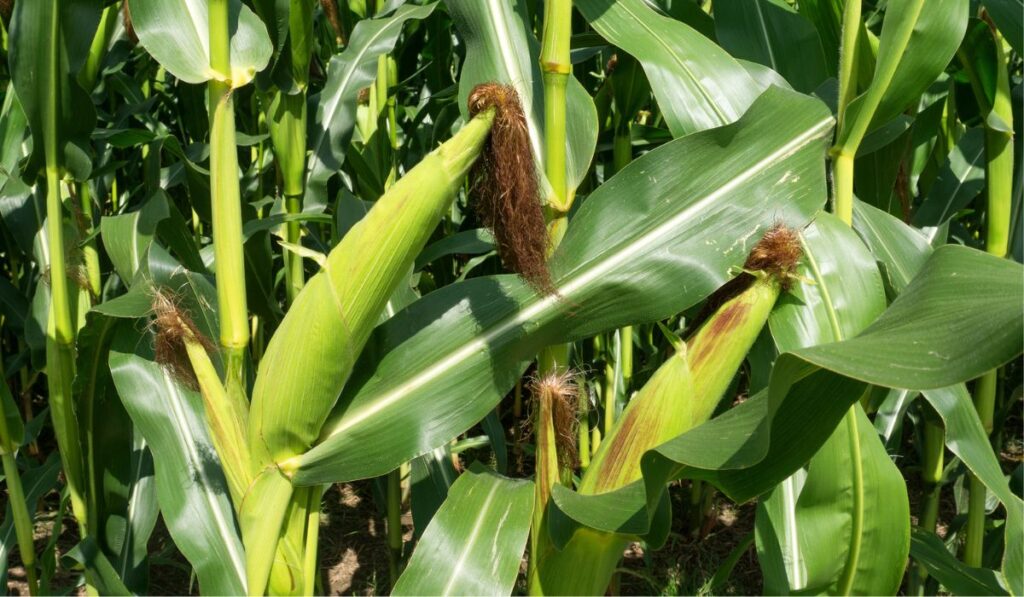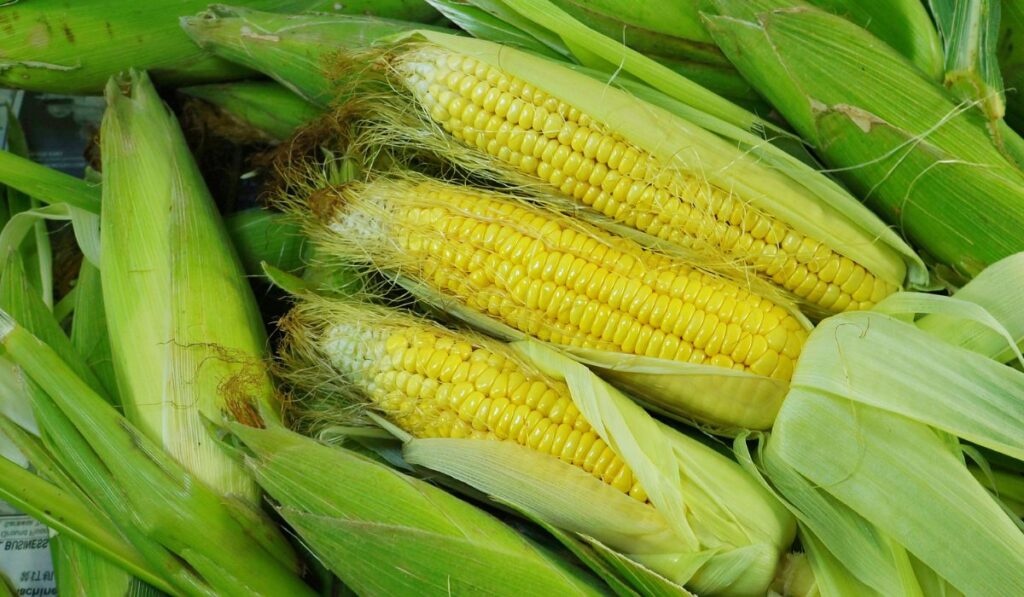Easy to grow and a favorite of all age groups, corn tastes more delicious when it’s freshly harvested. Sweet corn belongs to the grass family and needs plenty of space to grow; that’s why it’s recommended for large gardens. Corn varieties look the same from the outside, but corn can be yellow, white, red, or even bicolor under the husks.
Sweet corn is a warm-season annual crop. It’s planted in spring and is ready for harvest after three months of planting. Wind helps in pollinating its flowers. That’s why corn is planted in blocks of short rows. Soil temperature should be at least 60 degrees Fahrenheit when planting.
Nothing compares to homegrown corn. So let’s find out when and how you should plant sweet corn for the best result. We’ll also talk about the different varieties of corn available and how you should harvest your crop.
When is the Best Time to Plant Sweet Corn?
The best time to plant corn is in spring when there’s no danger of frost. The temperature of soil for planting sweet corn should be at least 60 degrees Fahrenheit.
Transplanting seedlings isn’t recommended; avoiding starting seeds indoors is better. Instead, planting your second round of corn a couple of weeks after the first round helps to extend the harvest.
Once the young corn plants reach the height of 4 inches, thin them to ensure a space of 12 to 18 inches between shorter varieties and 18 to 24 inches between the taller varieties.
Be careful when weeding to protect the corn roots from any damage. Corn has shallow roots, which can become stressed by drought. Therefore, keeping it well-watered, around 2 inches per week, is recommended.
Make sure the plant gets about 6 to 8 hours of direct sunlight. The soil should be well-draining but remain consistently moist, as corn needs a lot of water.
Mixing aged compost or manure into the soil during fall helps to get a better yield. However, if that’s not possible, mix in aged compost before planting corn seeds.
Wind pollination is crucial for the development of whole cobs of kernels. Therefore, shake the corn stalks every few days as long as the tassels are visible to increase the chances of more silk being pollinated.
Selecting a Planting Site
The best planting site for corn is one that has lots of sunshine and rich, well-draining soil. It’s also possible to grow smaller varieties in containers.
However, corn grows pretty tall, so make sure that you don’t plant corn near shorter crops as it might block their sunlight.
What are the Different Types of Sweet Corn?

Sweet corn belongs to the Poaceae (grass) family and relies on wind for the pollination of its flowers. That’s why corn is planted in blocks of short rows instead of long, single rows.
Packed full of antioxidants, fiber, and vitamins, this vegetable can be enjoyed in many ways. It can be eaten fresh, boiled, cooked, preserved, popped into popcorn, or ground into flour.
Many different varieties of corn are available and can be divided into six main categories. These include sweet corn, dwarf corn, popcorn, decorative corn, multicolored Indian corn, and corn for animal feed.
Some common cultivars for growing sweet corn are:
- Silver Queen: This early producer gets its name from its pale white kernels. It’s tender and highly disease-resistant, with a flavor worth waiting for. This plant grows up to 8 feet and can be harvested after 92 days.
- Tuxedo: Known for its delicate texture, succulent bite, and extra-sugary flavor, the Tuxedo variety has extra-long ears.
- Golden Bantam: A fast-maturing yellow variety highly popular for its great sweet flavor, the Golden Bantam is ideal for freezing and fresh eating. This heirloom sweet corn variety is also called the original sweet corn and is selected for its tenderness.
- Early Sunglow: This hybrid variety is best for places with short growing seasons. Sweet and tender, this variety is particularly noted for its exceptional resistance to frost and cold.
Sweet Corn vs. Popcorn
At first glance, popcorn and sweet corn may look similar, but some differences determine how they should be eaten. For example, popcorn is harvested when the kernels dry out, while sweet corn is harvested when the kernels are sweet and juicy.
Popcorn kernels are starchier compared to sweet corn kernels. However, their harder shell allows them to temporarily hold up to the pressure while the interior swells and pops during cooking.
How Much Yard Space Do You Need to Plant Sweet Corn?
As we’ve mentioned above, corn is pollinated by wind. That’s why it’s best to plant it in blocks instead of rows. Also, it’s vital for the pollen from male tassels to come into contact with the female silks, and planting them close ensures more contact.
Cross-pollination can occur due to wind pollination. Make sure to keep a distance of at least 25 feet between the different types of corn or plant corn varieties with different maturing times.
Corn seeds should be planted an inch deep, and a space of 8 to 12 inches should be maintained between them. Rows should be about 30 to 36 inches apart.
Planting in blocks of 4 rows instead of a single row ensures proper pollination. In addition, corn can grow without a support structure if planted in a spot sheltered from strong winds.
To speed up the germination process, moisten the seeds and wrap them in a moist paper towel. Now store these seeds in a plastic bag for 24 hours.
Fertilizing the soil with a 10-10-10 fertilizer at planting time helps the corn to proliferate. Don’t forget to water well at the time of planting.
Can You Propagate Sweet Corn?
To propagate sweet corn, you must save its seeds to plant them in the next season. It’s an excellent way to get more plants of a variety you particularly like but make sure there’s no cross-pollination.
Here’s how you can harvest seeds to save for the following growing season:
- Take a paper bag or a shoot bag and cover the corn ears you wish to save for seed when the first tassel appears.
- Leave the cobs on the plants for as long as possible to allow them to dry. Then, remove them when the fall weather becomes damp.
- To dry the ears completely, pull back the husks and hang them upside down in a cool, dry place.
- Remove the seeds from each corn ear once they’re completely dry. Place them in a paper bag and store them in a cool, dry place for planting the following season.
How to Harvest Sweet Corn

Typically it takes corn about 15 to 23 days after silking to become ripe. However, it tends to mature more quickly if the temperatures are exceptionally high.
Be sure to keep the following things in mind at the time of harvest:
- Corn ears shouldn’t be pointed but blunt or rounded, with the kernels milky and full and the tassels turning brown.
- When two ears grow on one stalk, the lower ear takes a couple of days more than the upper one to mature.
- To test the corn, pull back the husk and use your fingernail to pierce a kernel. If it’s milky or white, it’s ready. Remember that the milk stage is short.
- Pull the ears downwards to remove the corn from the stalk and then twist.
- Use the sugary varieties as soon as possible because they tend to lose their sweetness very quickly after harvesting.
- Eat or preserve the corn immediately after picking.
- Immature corn affected by late-season frost can damage the plants and cobs, resulting in the death of the poor-tasting corn or the plant.
In hot weather, when the temperature is over 85 degrees Fahrenheit, be sure to check the sweet corn frequently as it’s at its peak for 1 or 2 days only. Corn will not remain sweet if harvested a few days after the milk stage.
